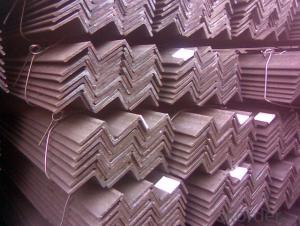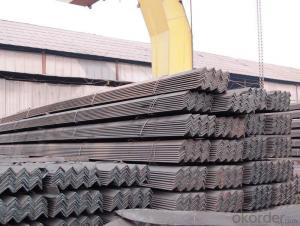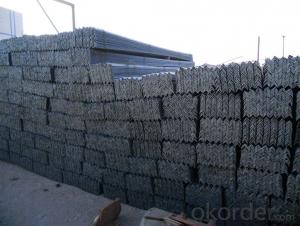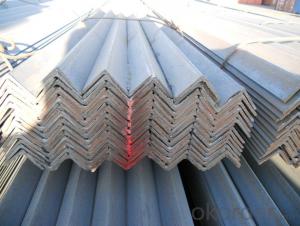Unequal Angle Steel Hot Rolled Steel, GB Standard Unequal Angle Steel
- Loading Port:
- Tianjin
- Payment Terms:
- TT or LC
- Min Order Qty:
- 25 m.t.
- Supply Capability:
- 20000 m.t./month
OKorder Service Pledge
OKorder Financial Service
You Might Also Like
Product Description:
OKorder is offering Unequal Angle Steel Hot Rolled Steel, GB Standard Unequal Angle Steel at great prices with worldwide shipping. Our supplier is a world-class manufacturer of steel, with our products utilized the world over. OKorder annually supplies products to European, North American and Asian markets. We provide quotations within 24 hours of receiving an inquiry and guarantee competitive prices.
Product Applications:
Unequal Angle Steel Hot Rolled Steel, GB Standard Unequal Angle Steel are ideal for structural applications and are widely used in the construction of buildings and bridges, and the manufacturing, petrochemical, and transportation industries.
Product Advantages:
OKorder's Unequal Angle Steel Hot Rolled Steel, GB Standard Unequal Angle Steel are durable, strong, and resist corrosion.
Main Product Features:
· Premium quality
· Prompt delivery & seaworthy packing (30 days after receiving deposit)
· Corrosion resistance
· Can be recycled and reused
· Mill test certification
· Professional Service
· Competitive pricing
Product Specifications:
Grade: Q235, Q235B, Q345, SS400, A36,St37-2
Standard: AISI, ASTM, GB, DIN, JIS
brand:nbsteels
MOQ:20mt
| Size( width*thickness )mm | width*thickness (kg/m) | Size( width*thickness )mm | width*thickness (kg/m) |
| 20*3 | 0.89 | 80*5 | 6.21 |
| 20*4 | 1.15 | 80*6 | 7.38 |
| 25*3 | 1.12 | 80*7 | 8.53 |
| 25*4 | 1.46 | 80*8 | 9.66 |
| 30*3 | 1.37 | 80*10 | 11.87 |
| 30*4 | 1.79 | 90*6 | 8.35 |
| 36*3 | 1.66 | 90*7 | 9.66 |
| 36*4 | 2.16 | 90*8 | 10.95 |
| 36*5 | 2.65 | 90*10 | 13.48 |
| 40*3 | 1.85 | 90*12 | 15.94 |
| 40*4 | 2.42 | 100*6 | 9.37 |
| 40*5 | 2.98 | 100*7 | 10.83 |
| 45*3 | 2.09 | 100*8 | 12.28 |
| 45*4 | 2.74 | 100*10 | 15.12 |
| 45*5 | 3.37 | 100*12 | 17.9 |
| 45*6 | 3.99 | 100*14 | 20.61 |
| 50*3 | 2.33 | 100*16 | 23.26 |
| 50*4 | 3.06 | 110*7 | 11.93 |
| 50*5 | 3.77 | 110*8 | 13.53 |
| 50*6 | 4.46 | 110*10 | 16.69 |
| 56*3 | 2.62 | 110*12 | 19.78 |
| 56*4 | 3.45 | 110*14 | 22.81 |
| 56*5 | 4.25 | 125*8 | 15.5 |
| 56*8 | 6.57 | 125*10 | 19.13 |
| 63*4 | 3.91 | 125*12 | 22.7 |
| 63*5 | 4.82 | 125*14 | 26.19 |
| 63*6 | 5.72 | 140*10 | 21.49 |
| 63*8 | 7.47 | 140*12 | 25.52 |
| 63*10 | 9.15 | 140*14 | 29.49 |
| 70*4 | 4.37 | 140*16 | 33.39 |
| 70*5 | 5.4 | 160*10 | 24.73 |
| 70*6 | 6.41 | 160*12 | 29.39 |
| 70*7 | 7.4 | 160*14 | 33.99 |
| 70*8 | 8.37 | 160*16 | 38.52 |
| 75*5 | 5.82 | 180*12 | 33.16 |
| 75*6 | 6.91 | 180*14 | 38.38 |
| 75*7 | 7.98 | 180*16 | 43.54 |
| 75*8 | 9.03 | 180*18 | 48.63 |
| 75*10 | 11.09 | 200*14 | 42.89 |
| 200*16 | 48.68 | ||
| 200*18 | 54.4 | ||
| 200*20 | 60.06 | ||
| 200*24 | 71.17 |
FAQ:
Q1: Why buy Materials & Equipment from OKorder.com?
A1: All products offered byOKorder.com are carefully selected from China's most reliable manufacturing enterprises. Through its ISO certifications, OKorder.com adheres to the highest standards and a commitment to supply chain safety and customer satisfaction.
Q2: How do we guarantee the quality of our products?
A2: We have established an advanced quality management system which conducts strict quality tests at every step, from raw materials to the final product. At the same time, we provide extensive follow-up service assurances as required.
Q3: How soon can we receive the product after purchase?
A3: Within three days of placing an order, we will begin production. The specific shipping date is dependent upon international and government factors, but is typically 7 to 10 workdays.
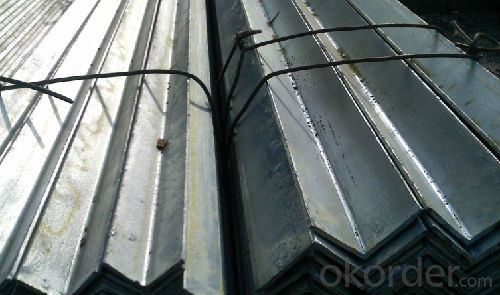
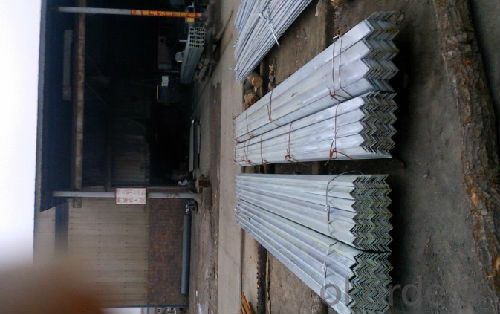
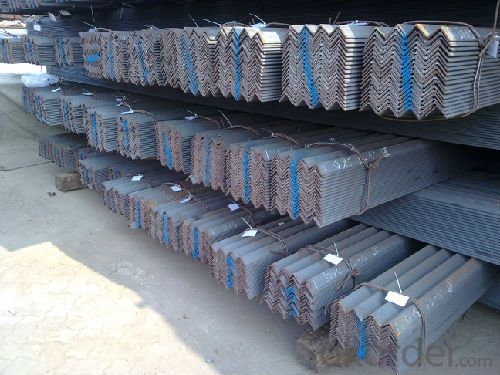
- Q:How do steel angles compare to aluminum angles?
- Different applications require different materials, with steel angles and aluminum angles having distinct properties and characteristics. Steel angles, also referred to as steel L-shaped beams, are known for their robustness and resilience. They find extensive use in construction projects like building frames, bridges, and industrial structures where their ability to bear heavy loads is essential. Comparatively, steel angles possess a higher tensile strength than their aluminum counterparts, allowing them to withstand greater forces without deformation or breakage. On the contrary, aluminum angles are lightweight and possess exceptional corrosion resistance. This makes them ideal for applications where weight is a crucial factor, such as the aerospace and marine industries. Additionally, aluminum angles are commonly employed in architectural projects due to their malleability and ability to be shaped into various designs. Furthermore, aluminum angles exhibit commendable thermal and electrical conductivity properties, making them well-suited for heat transfer applications. When it comes to cost, steel angles are generally more budget-friendly due to lower steel production costs. However, aluminum angles often demand less maintenance and boast a longer lifespan, thanks to their resistance against corrosion. Ultimately, the selection between steel angles and aluminum angles is contingent upon the specific requirements of the project. If the priority is high strength and durability, steel angles are the preferred option. Conversely, if weight, corrosion resistance, and design flexibility hold greater importance, aluminum angles are the superior choice.
- Q:Galvanized steel angles under what conditions?
- Galvanized angle itself coated zinc and iron rust, common need to be coated with a layer of anti rust paint in the construction process, so the galvanized angle in the construction without paint. Suitable for field and outdoor support and Engineering
- Q:Can steel angles be used in railway or transportation infrastructure?
- Steel angles have the potential to be utilized in railway or transportation infrastructure. They are frequently employed in the building of bridges, tunnels, and railway tracks. These infrastructure components rely on steel angles for structural support and stability. The reputation of steel angles stems from their strength, durability, and versatility. They can be effortlessly fabricated and installed, which contributes to their popularity in transportation projects. Additionally, steel angles possess the ability to endure substantial loads and adverse weather conditions, rendering them suitable for railway and transportation purposes where safety and reliability are of utmost importance. In summary, steel angles offer a dependable and cost-effective solution for railway and transportation infrastructure needs.
- Q:Are steel angles fire resistant?
- Yes, steel angles are generally considered to be fire resistant. Steel is an inherently non-combustible material and has a high melting point, making it able to withstand high temperatures during a fire. Steel angles, which are L-shaped structural members, are commonly used in construction and engineering applications due to their strength and durability. In fire conditions, steel angles can maintain their structural integrity and resist deformation, which is crucial for the safety of a building or structure. However, it is important to note that the fire resistance of steel angles can be affected by factors such as the size and thickness of the angles, the type of fire protection measures applied, and the duration and intensity of the fire. Fire protection measures like fire-resistant coatings, fire barriers, and fireproofing materials can be used to enhance the fire resistance of steel angles and improve the overall fire safety of a structure.
- Q:Can steel angles be used for manufacturing balcony structures?
- Indeed, balcony structures can be manufactured using steel angles. The utilization of steel angles in construction is widespread owing to their robustness and endurance. They offer structural reinforcement and steadiness, rendering them appropriate for balcony structures. Balcony construction frequently incorporates steel angles as supporting beams or framing elements, establishing a sturdy foundation for the flooring and railing. Moreover, steel angles can be effortlessly fabricated and tailored to conform to precise design specifications, making them a versatile option for manufacturing balconies.
- Q:Are steel angles heat-treated?
- Steel angles are indeed capable of undergoing heat treatment. To modify the physical and mechanical properties of the steel, controlled heating and cooling processes are employed in heat treatment. This can yield various desirable attributes, such as enhanced strength, hardness, toughness, or improved machinability. When it comes to heat treating steel angles, commonly employed techniques include annealing, quenching, tempering, or normalizing. The selection of a specific heat treatment method is contingent upon the desired final properties and the intended application of the steel angles.
- Q:What is the purpose of using steel angles in construction?
- Steel angles are commonly used in construction for several purposes. The primary purpose of using steel angles is to provide structural support and stability to various components of a building or structure. These angles are often used to reinforce corners, edges, and joints, adding strength and rigidity to the overall structure. Additionally, steel angles are used to distribute and transfer loads or forces within the construction. They help to evenly distribute the weight and stress across different parts of the structure, preventing any concentrated points of weakness. Moreover, steel angles are versatile and can be easily customized and fabricated to meet specific construction requirements. They can be cut, drilled, and welded, allowing for seamless integration into a wide range of construction projects. Furthermore, steel angles offer excellent durability and resistance to corrosion, making them suitable for both indoor and outdoor applications. They can withstand heavy loads, extreme weather conditions, and provide long-lasting support to the structure. In summary, the purpose of using steel angles in construction is to enhance the structural integrity, provide support and stability, distribute loads, and ensure the longevity of the building or structure.
- Q:How do you handle and install steel angles on a construction site?
- To handle and install steel angles on a construction site, one must carefully plan and pay attention to detail. Here is a breakdown of the necessary steps: 1. Site preparation: Before handling steel angles, it is crucial to properly prepare the construction site. This involves clearing debris and obstructions, ensuring a stable and level surface, and taking necessary safety precautions. 2. Measurement and marking: Accurate measurements of the steel angles' dimensions and their placement on the site are essential. Use a measuring tape to determine length, width, and thickness, and mark their intended locations. This guarantees proper alignment and fit during installation. 3. Handling and transport: Steel angles can be heavy, so it is important to use appropriate lifting equipment like cranes, hoists, or forklifts. Ensure that the lifting equipment is rated correctly and operated by trained personnel to prevent accidents or damage to the steel angles. 4. Securing the angles: Once the steel angles are in place, use suitable fasteners such as bolts, screws, or welding to secure them. The choice of fasteners depends on the project's requirements and the load-bearing capacity of the steel angles. Follow manufacturer guidelines and industry standards for proper fastener selection and installation. 5. Alignment and leveling check: After securing the angles, use a level and measuring tools to check their alignment and levelness. This step ensures correct installation and the necessary structural support. 6. Inspection and reinforcement: Thoroughly inspect the installed steel angles to ensure they are free from defects or damages. If any issues are found, take appropriate action to reinforce or replace the angles, maintaining the site's structural integrity. 7. Ongoing maintenance: Regular maintenance is necessary to extend the lifespan of steel angles and prevent corrosion. Follow manufacturer recommendations and periodically inspect the angles to address any issues promptly. In conclusion, handling and installing steel angles on a construction site require careful planning, proper equipment, and adherence to safety guidelines. By following these steps, construction professionals can ensure successful installation, contributing to the overall strength and stability of the structure.
- Q:What is the typical thickness of the base of a steel angle?
- The typical thickness of the base of a steel angle can vary depending on the specific application and design requirements. However, it is common for steel angles to have a base thickness ranging from 1/8 inch to 3/4 inch.
- Q:Can steel angles be used in the construction of hotels?
- Yes, steel angles can be used in the construction of hotels. Steel angles are commonly used in construction due to their durability, strength, and versatility. They can be used for a variety of purposes in hotel construction, such as supporting structural beams, reinforcing concrete slabs, framing walls, and creating architectural features. Steel angles provide stability and structural integrity, making them ideal for high-rise buildings like hotels. Additionally, steel angles are cost-effective and readily available, making them a practical choice for hotel construction projects.
1. Manufacturer Overview |
|
|---|---|
| Location | |
| Year Established | |
| Annual Output Value | |
| Main Markets | |
| Company Certifications | |
2. Manufacturer Certificates |
|
|---|---|
| a) Certification Name | |
| Range | |
| Reference | |
| Validity Period | |
3. Manufacturer Capability |
|
|---|---|
| a)Trade Capacity | |
| Nearest Port | |
| Export Percentage | |
| No.of Employees in Trade Department | |
| Language Spoken: | |
| b)Factory Information | |
| Factory Size: | |
| No. of Production Lines | |
| Contract Manufacturing | |
| Product Price Range | |
Send your message to us
Unequal Angle Steel Hot Rolled Steel, GB Standard Unequal Angle Steel
- Loading Port:
- Tianjin
- Payment Terms:
- TT or LC
- Min Order Qty:
- 25 m.t.
- Supply Capability:
- 20000 m.t./month
OKorder Service Pledge
OKorder Financial Service
Similar products
New products
Hot products
Hot Searches
Related keywords
